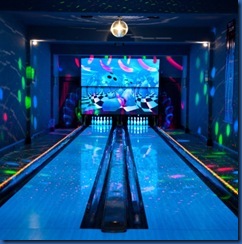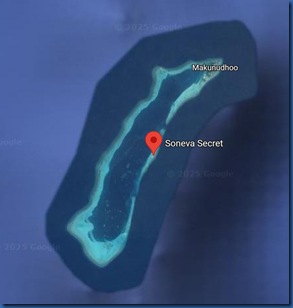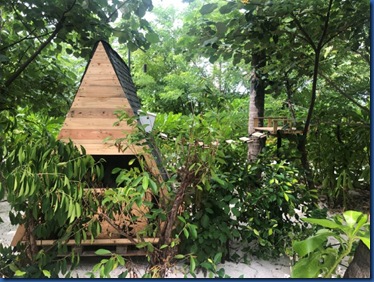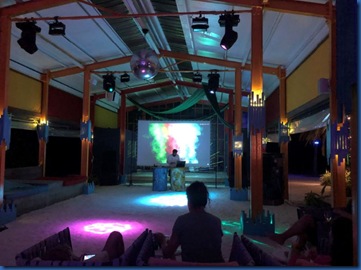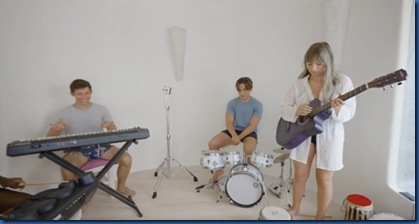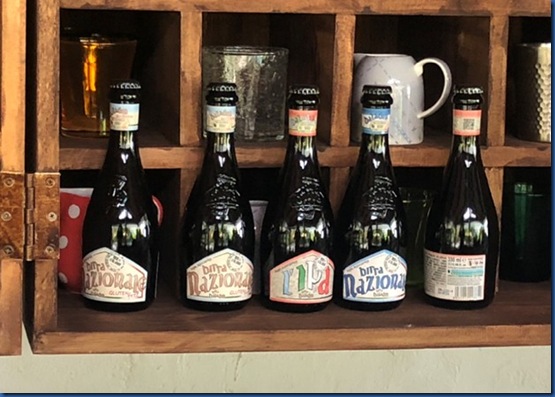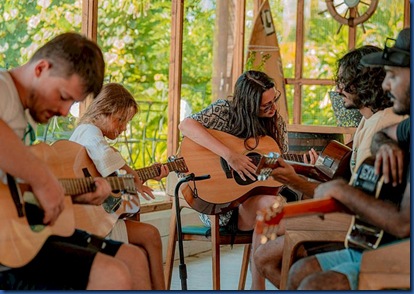Another piece of Oaga aesthetic woodwork is something we would love to take home are their bathroom barn doors. In fact, one of the questions in “The Interview Game” is “If you could take anything that you saw on the trip home (any size – a piece of art, a device, etc) for no cost, what would it be?” We couldn’t get Oaga’s into our baggage, but we will be integrating these style doors into our bathroom renovation.
Best of the Maldives: Wooden Amenities – Oaga
The move away from environmentally unfriendly plastics to more natural materials isn’t just good sustainability, but it is also great aesthetics. I love things made out of wood. Every year, I gave my godson a Christmas gift that was always wood. Oaga is giving away completely wooden sets of toiletry amenities for its guests which are as kind on the eye as they are on the environment.
Best of the Maldives: Bowling – Kandima
With all of the sunshine and sea in the Maldives sometimes you want an escape from the heat and salt. All resorts have some typical board games and maybe a makeshift movie screen in an air conditioned indoor area. The kids club have plenty of activities but for kids only. But for some active, family fun Kandima has introduced its very own bowling alley:
- “Have a blast at our two full-sized bowling lanes, perfect for everyone. Come and strike those pins down with modern equipment and scoring system.”
Best of the Maldives: Isolation – Soneva Secret
One of the many charms of the Maldives destination is the Crusoe sense of isolation and distant separation from the increasingly hustle-bustle of daily modern life. My one phrase to describe the aesthetic of the Maldives is “that iconic cartoon of a plot of sand with a palm tree on it”. Soneva’s latest property, Soneva Secret, takes that concept to its own extreme situated in it own mini single-island atoll.
- “There is no other resort in the Maldives where, as far as the eye can see, there is no other development and just nature”
Get away from it all…including the rest of the Maldives.
Best of the Maldives: Cat Villa – Oaga
Maldives resort feature quite a menagerie of friendly furry friends…bunnies, flying foxes, cats (no dogs though, not allowed in the Muslim country). They wander freely and spoiled with attention from guests and resort staff alike. But Oaga pampers its felines with their very own luxury villas in the design style of the hooman ones!
Best of the Maldives: Dinner Theatre – Oaga
Delicacies, entertainment, culture…all the evening possibilities on a resort rolled into a single event. Dinner theatre is a great way to spice up your meal and to enjoy some theatrics in a most leisurely manner. Oaga premiered its first dinner theatre spectacle telling the story of star-crossed lovers Dhon Hiyala and Alifulhu’ (Oaga likes the romantic genre – Best of the Maldives: Pool Channel – Oaga – Maldives Complete Blog)
- · “Oaga Art Resort has premiered a one-of-a-kind dining experience for Valentine’s Day at their luxury resort in the Maldives. In partnership with their own theatre team at Samaasaa the specialty restaurant, they introduced a five-course dinner by the beach paired with a live performance of the Maldivian tale of two star crossed lovers ‘Dhon Hiyala and Alifulhu’, creating an unforgettable evening for the audience. The theatrical dining experience is a first of its kind in the Maldives, providing guests with a unique and immersive experience that combines exceptional cuisine with a captivating live performance. Oaga Art Resort’s talented chefs, headed by Chef Zuhair, have created a five-course menu that features fresh and seasonal ingredients sourced locally.”
Best of the Maldives: Disco – Oaga
- “Oh disco heaven, oh disco heaven” – Lady Gaga
A common FAQ is about the “nightlife” and “entertainment” on offer by the resort. I guess all that relaxation from lounging in the sun and soaking up the indolent poolside vibes during the day can generate some pent up energy for the evening. All too often, the “disco” or “dance floor” is a small square of by the beach bar and near a DJ deck. But Oaga has created a vibrant night spot that would stand out in the London club scene. Lights, ample space, lounging beds, great DJ, great sound systems all on a destination-distinctive sand-floor (for really kicking your shoes off).
Best of the Maldives: Music Room – Soneva Jani
Make your own music at Soneva Jani’s special music room in it’s the Den kids club where an entire band of instruments are available for a jam session.
Best of the Maldives: Craft Beer – Oaga
Another “Finally Seen”, this one over a decade since I declared it in #5 Haven’t Seen post (#8) in 2014. And not only does Oaga feature craft beer on the resort, it does so at its own special pool bar where they also have beer tastings that are included in the AI package.
Best of the Maldives: Music Classes – Oaga
Exploration doesn’t have to be limited to just underwater adventures or tropical excursions. People can expand their horizons by trying a new activity or even delving into a new skill. Many people find holidays a great chance to try something new away from the pressures and stresses of daily life. Oaga offers a range of classes for guests looking to explore their musical side at their Ka Studio which includes guitar, ukulele, and bodu beru.



